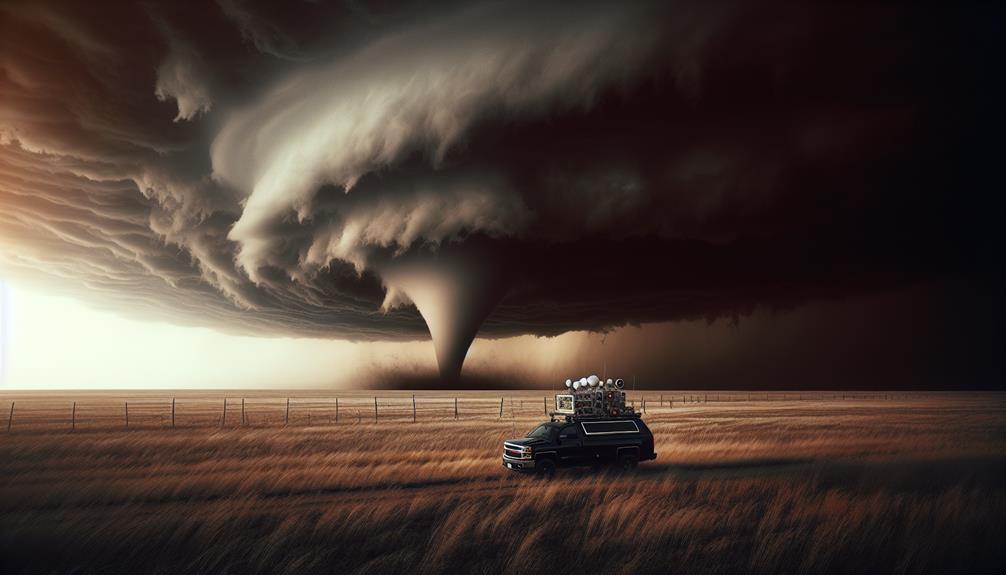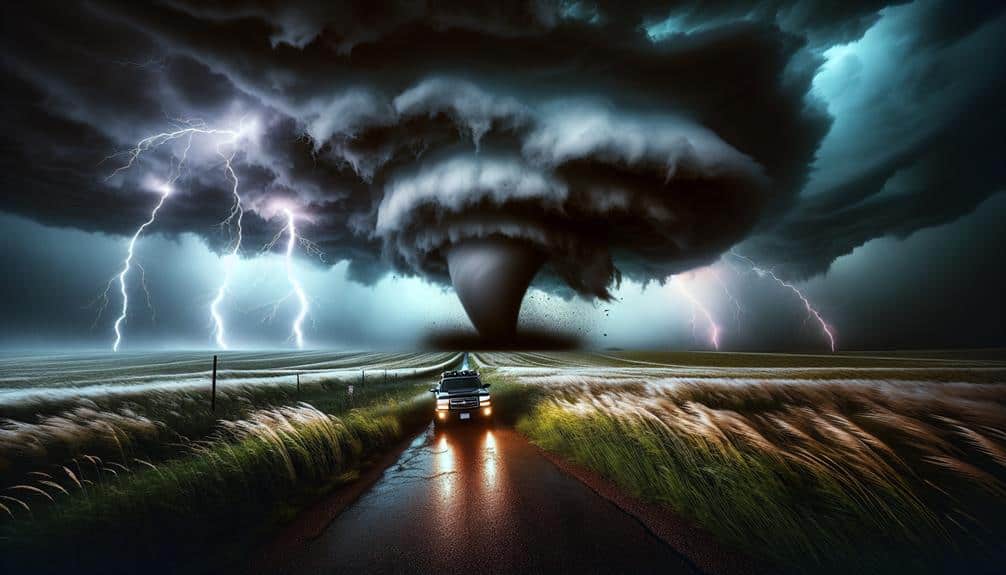Storm chasing gear is crucial for documentaries because it ensures our safety and captures critical data. High-quality cameras with weather sealing allow us to document storm phenomena in stunning detail, while advanced weather instruments like anemometers and Doppler radar provide precise atmospheric readings. Essential safety equipment, such as thermal blankets and first aid kits, keeps our team protected. Reliable communication tools, including satellite phones and two-way radios, maintain connectivity. Durable, weather-resistant protective clothing and robust power supplies support prolonged fieldwork. Each piece of gear plays a pivotal role in capturing the raw power of storms, revealing more about their extraordinary nature.
Key Points
- Ensures safety and preparedness during unpredictable and hazardous storm conditions.
- Provides accurate and real-time meteorological data for reliable storm documentation.
- Captures high-resolution, detailed visuals crucial for compelling storytelling.
- Facilitates reliable communication and live broadcasting from remote locations.
Safety Equipment
When storm chasing, having the right safety equipment is vital to protect ourselves from severe weather hazards. Emergency preparation begins with a detailed risk assessment of potential storm paths and their severity. Data from meteorological sources helps us predict these paths accurately. By analyzing this data, we can determine the appropriate safety measures.
Our survival gear should include items like multipurpose tools, thermal blankets, and a reliable communication device. These tools are necessary for dealing with unexpected situations. For instance, thermal blankets can prevent hypothermia if temperatures plummet unexpectedly. A communication device ensures we're always in contact with emergency services.
First aid kits are another essential component of our safety equipment. In-depth kits should include bandages, antiseptics, and pain relief medications. Data from past storm chases indicate a higher incidence of minor injuries, making first aid kits indispensable.
Additionally, having a well-planned emergency preparation plan is essential. This plan should outline evacuation routes, safe zones, and emergency contacts. By following these safety measures, we can minimize risks and maximize our freedom to document the awe-inspiring power of nature with confidence.
High-Quality Cameras
We need high-quality cameras with superior image resolution to capture the intricate details of storm phenomena.
These cameras should also include enhanced durability features to withstand extreme weather conditions.
Superior Image Resolution
For unmatched image resolution, high-quality cameras equipped with large sensors and advanced optics are essential in storm chasing documentaries. As improved technology continues to evolve, our capability to capture the intricate details of storms has reached unparalleled heights. Large sensors enhance light sensitivity, allowing us to record stunning visuals even in low-light conditions. This is vital for capturing the dramatic and often dark environments of storm events.
In terms of visual storytelling, high-quality cameras offer superior image resolution that brings every frame to life. The ability to capture minute details, from the swirling patterns of tornadoes to the subtle shifts in cloud formations, significantly enhances our narrative. We can illustrate the sheer power and beauty of nature with a clarity that deeply connects with our audience.
Furthermore, advanced optics play a fundamental role in achieving this level of detail. Features such as high dynamic range (HDR) and wide color gamuts make sure that colors are vibrant and true to life. This not only enhances the aesthetic quality of our footage but also assists scientific analysis by providing accurate visual data.
Enhanced Durability Features
Equally important to capturing stunning visuals, our high-quality cameras must possess enhanced durability features to withstand the harsh and unpredictable conditions of storm chasing. This means our equipment needs to deliver long-lasting performance and maintain functionality under extreme stress. To achieve this, we focus on rugged construction and use materials that can endure the elements.
Key features to look for in durable cameras include:
- Weather Sealing: Protects against rain, dust, and other environmental factors, ensuring the camera can operate in severe weather conditions.
- Shock Resistance: Absorbs impacts from drops or collisions, pivotal when we're maneuvering through rough terrain.
- Temperature Tolerance: Operates efficiently in both high and low temperatures, maintaining performance regardless of ambient conditions.
Weather Instruments
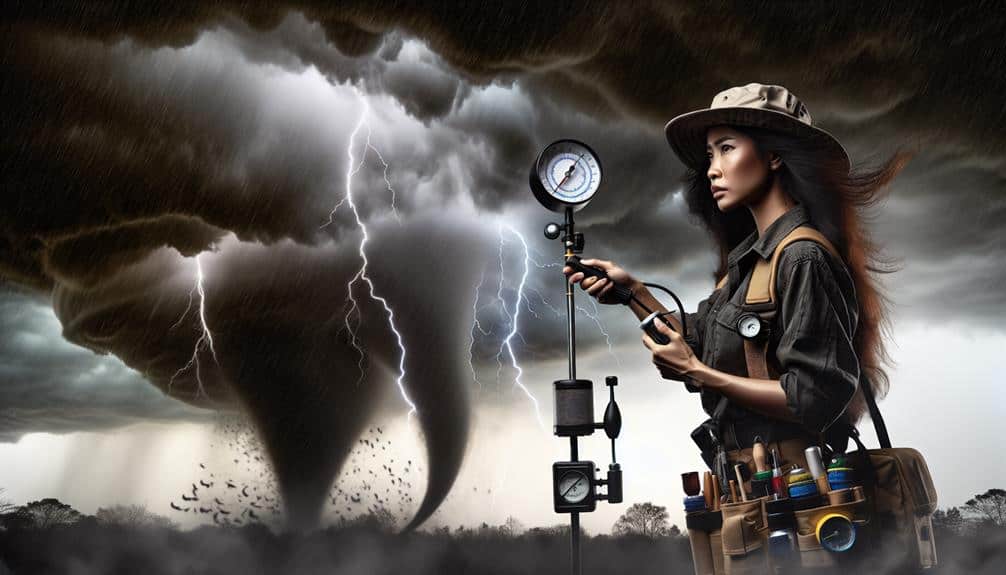
Equipped with advanced weather instruments, storm chasers can accurately measure and document atmospheric conditions in real-time. This precision in data collection is essential for the success of any documentary focused on severe weather phenomena. Instruments such as anemometers, barometers, and hygrometers provide us with necessary readings on wind speed, atmospheric pressure, and humidity levels. By leveraging these tools, we enhance our forecasting accuracy, allowing us to predict storm behavior more reliably and plan our documentary shoots effectively.
Our mobile weather stations integrate GPS technology and Doppler radar systems, providing a detailed suite of meteorological data. This integration lets us map storm paths and track changes in real-time, which is important for both safety and storytelling. The ability to analyze and interpret this data on the fly gives us the flexibility to adapt our plans and capture the most captivating footage.
Furthermore, deploying weather balloons equipped with radiosondes helps us gather vertical profiles of the atmosphere. This data supplements our ground-based readings and improves our overall understanding of storm dynamics. By investing in these advanced weather instruments, we empower ourselves to create documentaries that not only inform but also inspire awe and respect for nature's power.
Communication Tools
While our advanced weather instruments provide essential data for storm prediction and documentation, effective communication tools are equally vital to guarantee coordination and safety during storm chasing expeditions. Our ability to stay connected, share real-time data, and secure team synchronization hinges on the robustness of our communication setup.
Satellite communication is a primary tool, offering reliable connectivity in remote areas where traditional networks fail. With satellite phones and data terminals, we can maintain an uninterrupted link with our base station, ensuring constant updates on storm trajectories and emergency protocols.
Live streaming equipment, on the other hand, allows us to broadcast real-time footage to our production teams and audience, enhancing the immediacy and impact of our documentary content.
Key communication tools include:
- Satellite Phones: For reliable voice communication regardless of location.
- Data Terminals: Facilitates real-time data transfer and internet access via satellites.
- Live Streaming Kits: Enables high-quality, real-time video broadcasting.
Protective Clothing
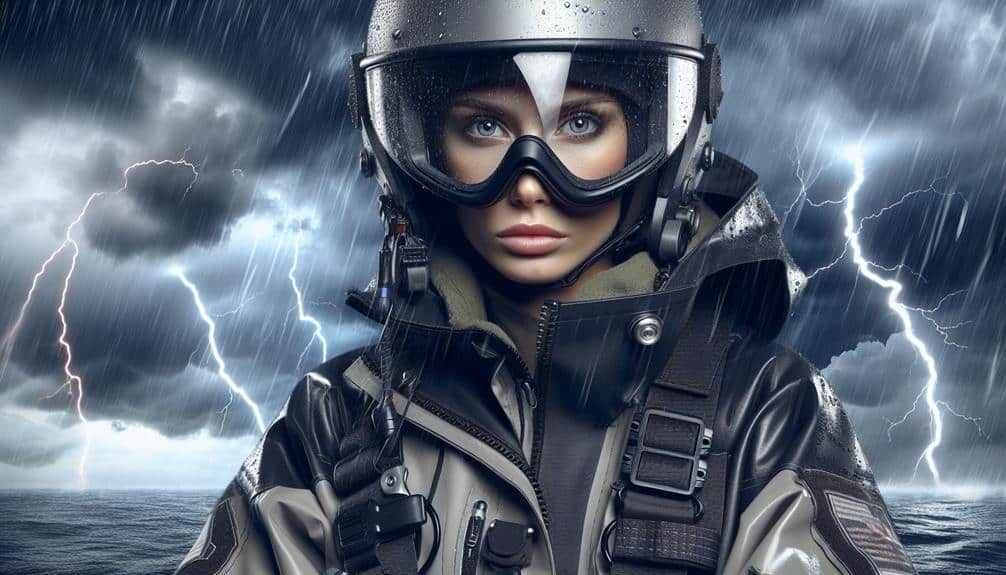
When we choose protective clothing, we prioritize weather-resistant materials to guarantee durability in extreme conditions.
We also integrate high-visibility safety features to enhance team safety during low-visibility scenarios.
These elements are essential for minimizing risk and maintaining operational efficiency.
Weather-resistant Material Importance
Choosing weather-resistant materials for our protective clothing is indispensable to guarantee durability and safety during storm chasing expeditions. The extreme conditions we face require gear that can withstand high winds, torrential rains, and flying debris.
By investing in durable technology and waterproof gear, we maintain our ability to capture critical footage without compromising our well-being.
To achieve this, our protective clothing must meet several key criteria:
- Waterproofing: It's essential to prevent water ingress, thereby keeping us dry and avoiding hypothermia.
- Breathability: High-performance fabrics that allow sweat to evaporate help maintain comfort during prolonged exposure.
- Abrasion Resistance: Materials that resist wear and tear extend the lifespan of our gear, making it a cost-effective investment.
High-visibility Safety Features
High-visibility safety features in our protective clothing are necessary to guarantee we remain visible and safe during storm chasing expeditions. Reflective gear greatly improves our visibility, especially in low-light conditions often encountered near severe weather. Reflective strips and patches on our jackets and pants guarantee that we can be easily spotted by both team members and emergency personnel, reducing the risk of accidents.
Bright colors, such as neon yellow or orange, are another vital component of our protective features. These colors stand out against the typically dark and chaotic backdrop of a storm, making sure we don't blend into the environment. According to recent data, high-visibility clothing can decrease the likelihood of roadside incidents by up to 47%. This is extremely important when we're operating near fast-moving vehicles or unstable structures.
In addition to improving visibility, the safety provided by these features is paramount. High-visibility gear is designed to be both durable and functional, allowing us the freedom to move efficiently while remaining protected. The integration of such protective features in our storm chasing gear not only safeguards our well-being but also secures the success of our documentary endeavors.
Power Supplies
Reliable power supplies are necessary for storm chasing documentaries, ensuring that all equipment functions seamlessly during pivotal moments. When we're out in the field, the last thing we need is a power failure that could compromise our footage or data collection. To mitigate such risks, we rely heavily on a variety of power solutions.
Portable chargers: These are indispensable for keeping cameras, communication devices, and sensors operational. High-capacity models with quick-charge capabilities guarantee that our gear is always ready for action.
Backup batteries: Having multiple sets of backup batteries for all devices is essential. We opt for lithium-ion batteries due to their high energy density and longer lifespan.
Power inverters: These convert the DC power from our vehicle's battery to AC power, allowing us to charge and operate equipment directly from the car, providing flexibility and extended operational time.
Emergency lighting: Reliable emergency lighting systems are crucial for nighttime operations. LED-based lights with rechargeable batteries provide efficient, long-lasting illumination.
Storage Solutions
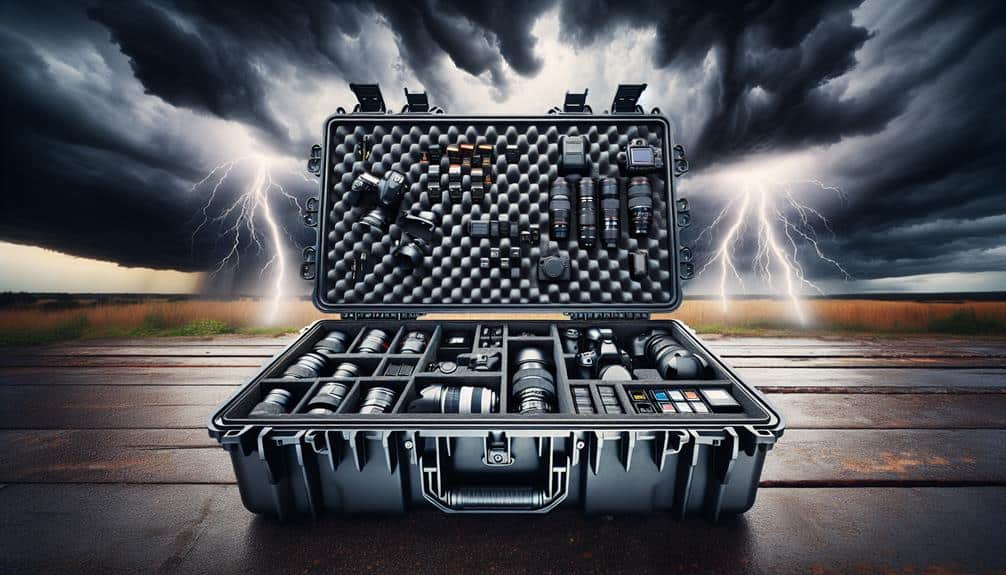
Effective storage solutions are important for ensuring the secure and organized management of footage and data collected during storm chasing expeditions. We need to implement robust organizational systems to handle the vast amount of data generated.
High-capacity, solid-state drives (SSDs) provide faster data transfer rates and greater reliability compared to traditional hard drives. These devices also better withstand the physical demands of storm chasing, reducing the risk of data corruption.
Weatherproof options are necessary for gear protection. We should utilize rugged, waterproof storage cases to shield our drives and memory cards from harsh weather conditions. These cases often come with customizable foam inserts, allowing us to create tailored compartments for each piece of equipment, thereby enhancing organizational efficiency.
Regular equipment maintenance is another important factor. Dust, moisture, and debris can compromise our storage devices, so it's essential to clean and inspect them after each expedition. Anti-static bags and silica gel packets can further protect our gear from environmental damage.
Frequently Asked Questions
How Do Storm Chasers Choose the Best Locations for Filming?
We analyze weather patterns to optimize location selection, ensuring prime conditions for filming. Advanced filming techniques require precise equipment maintenance. Our goal is freedom to capture compelling footage safely and effectively in unpredictable environments.
What Is the Training Process for Becoming a Storm Chaser?
The training process for becoming a storm chaser includes rigorous meteorology training and extensive field experience. We analyze weather patterns, learn forecasting techniques, and practice safety protocols to guarantee we capture valuable data while minimizing risks.
How Do Storm Chasers Predict Severe Weather Patterns?
We predict severe weather patterns using advanced forecasting techniques like computer models, radar data, and satellite imagery. By analyzing these data points, we accurately identify potential storm formations and track their movements, ensuring we stay ahead of the storm.
What Role Does Teamwork Play in Successful Storm Chasing?
Team dynamics and effective communication are vital for storm chasing. Our support systems and collaboration guarantee safety and data accuracy. We rely on each other's expertise and real-time information sharing to navigate severe weather patterns successfully.
How Do Storm Chasers Handle Emergency Situations During a Chase?
During emergency situations, we rely on rigorous emergency preparedness and strict safety protocols. We analyze real-time data, ensuring everyone's safety while maintaining operational freedom. Our team's coordination and adherence to protocols are essential for handling unexpected dangers effectively.

